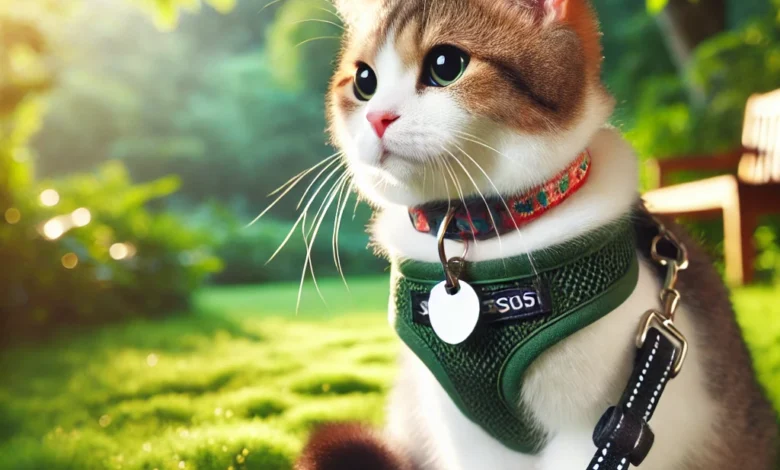Cat Collar or Harness? Choosing the Right One for Your Pet

Cats are naturally curious creatures, and as pet parents, we always want what’s best for them. Whether you’re taking your cat on outdoor adventures or simply ensuring their safety at home, choosing between a cat collar or a harness can be a significant decision.
While both have their unique benefits, the right choice depends on your cat’s personality, lifestyle, and comfort level. This guide will explore the differences between collars and harnesses, their pros and cons, and how to select the best option for your feline friend.
Why Do Cats Need a Collar or a Harness?
Before diving into the comparison, it’s essential to understand why a cat might need a collar or harness in the first place. Here are some key reasons:
- Identification & Safety: A collar with an ID tag can help reunite lost cats with their owners.
- Training & Outdoor Exploration: Harnesses allow cats to experience the outdoors safely.
- Control & Security: Both collars and harnesses provide some level of control, preventing escapes or accidents.
- Health & Exercise: Walking on a harness encourages exercise and mental stimulation.
Now, let’s explore the differences between these two options.
Cat Collars: Features, Benefits, and Considerations
What is a Cat Collar?
A cat collar is a simple band that goes around your cat’s neck. It can come in various materials like nylon, leather, or fabric and may include features like ID tags, bells, and breakaway mechanisms for safety.
Pros of Cat Collars
- Easy Identification
- A collar with an ID tag makes it easy for someone to contact you if your cat gets lost.
- Microchips are great but require a scanner, while an ID tag provides immediate information.
- Lightweight & Comfortable
- Many cats adjust quickly to collars since they are lightweight and less restrictive than a harness.
- Perfect for indoor cats who don’t require heavy-duty gear.
- Breakaway Safety Feature
- Designed to release if caught on something, preventing choking or injuries.
- Ensures safety if the cat gets tangled in furniture or branches.
- Helps with Flea Prevention
- Some collars can carry flea-repelling properties, providing additional protection for your pet.
Cons of Cat Collars
- Risk of Getting Caught
- Even with a breakaway feature, collars can get stuck on furniture, fences, or tree branches.
- Limited Control
- Unlike a harness, a collar does not provide enough control for leash-walking or training.
- Not Ideal for Outdoor Adventures
- If your cat enjoys exploring outside, a collar alone won’t prevent them from slipping away.
Who Should Choose a Collar?
- Owners who want an easy way to display identification.
- Cats that live indoors but may have occasional outdoor access.
- Felines that don’t tolerate harnesses or don’t need to be walked.
Whether you prefer a collar or harness, find the best options at https://furlove365.com/.
Cat Harnesses: Features, Benefits, and Considerations
What is a Cat Harness?
A cat harness is a more secure option that wraps around the cat’s chest and shoulders. It distributes pressure evenly, making it safer and more comfortable for leash-walking.
Pros of Cat Harnesses
- Better Control & Safety
- A harness prevents choking and distributes pressure evenly across the body.
- Ideal for outdoor walks, car travel, and vet visits.
- Reduces the Risk of Escape
- Cats can slip out of collars easily, but a well-fitted harness is much harder to escape from.
- Keeps your cat safe during outdoor adventures.
- Encourages Outdoor Exploration
- Allows your cat to enjoy fresh air and nature safely.
- Reduces indoor boredom and provides mental stimulation.
- Protects from Injuries
- Since a harness distributes pressure, there is less strain on your cat’s neck and spine.
- This is especially beneficial for older cats or those with respiratory issues.
Cons of Cat Harnesses
- Takes Time to Adjust
- Some cats may resist wearing a harness at first and need time to get used to it.
- Training and patience are required for successful use.
- More Effort to Put On
- Unlike collars, harnesses require a bit more effort to put on and adjust properly.
- Not Ideal for Permanent Wear
- Unlike collars, harnesses aren’t designed for all-day wear. They should be used only for specific activities.
Who Should Choose a Harness?
- Cat owners who want to walk their pets outdoors.
- Cats that are adventurous and enjoy exploring.
- Owners who prioritize safety and control over convenience.
How to Choose the Right Option for Your Cat
Now that you understand the benefits of both collars and harnesses, how do you choose the right one for your cat? Here are a few key considerations:
1. Consider Your Cat’s Personality
- If your cat is independent and prefers minimal restraint, a collar may be the better choice.
- If your cat is curious, energetic, and enjoys outdoor adventures, a harness will offer more safety and security.
2. Assess Your Cat’s Lifestyle
- Indoor-only cats: A breakaway collar with an ID tag is usually enough.
- Outdoor or leash-trained cats: A harness is the best choice for safety and control.
3. Safety First
- Always prioritize safety features like breakaway collars and well-fitted harnesses.
- Avoid harnesses that are too loose, as cats can wiggle out of them.
4. Comfort Matters
- Choose soft, lightweight materials that won’t irritate your cat’s skin.
- Test different styles to see which one your cat tolerates best.
Training Your Cat to Wear a Collar or Harness
Regardless of your choice, your cat may need time to adjust. Here’s how to make the process easier:
Step 1: Start Slow
- Let your cat sniff and explore the collar or harness before putting it on.
Step 2: Use Positive Reinforcement
- Offer treats and praise when your cat allows the collar or harness to be placed on them.
Step 3: Gradual Wear Time
- Start with short periods and gradually increase the duration as your cat gets comfortable.
Step 4: Monitor Behavior
- If your cat shows signs of discomfort or stress, remove the collar or harness and try again later.
Final Thoughts: Which One is Best for Your Cat?
Both collars and harnesses have their benefits, but the best choice depends on your cat’s needs and lifestyle. If you want an easy identification method, a breakaway collar is a great choice. However, if you plan to take your cat on outdoor walks, a secure harness is the better option.
Ultimately, the best approach is to consider your cat’s comfort, safety, and personality before making a decision. Whether you choose a collar, a harness, or even both, your cat’s happiness and well-being should always come first.



